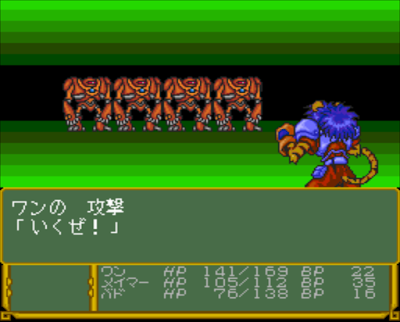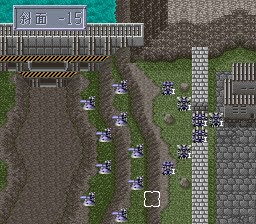This was Pioneer LDC’s first game release, a real-time strategy RPG. After the initial release there was a remake for Playstation called Bounty Sword First in 1997. A number of changes were made and some fans did not like them, although generally the game was well received. The “First” title showed their intention to have a trilogy. But the second game, Bounty Sword Double Edge, was a critical and sales failure, and the third game never game out.
I vacillated for a while over whether I should play the PSX remake or not. In the end, the addition of permanent death to the PSX version tipped the scales for me to play the original game. In the SFC version if a character dies in a battle you pay a healing cost and they have to sit out the next battle.
The main character, who you name (Kurisu), is a former knight. He is famed as the Master of Sword, although he’s also has the reputation of having killed his own companions. He is now a burnt-out bounty hunter, doing jobs that pay money. He has this fairy with him who isn’t explained at all in the game; from a game system standpoint she explains how you can see what’s happening all over the battle map, but at least as of map 22 there’s no explanation of who she is except that she chose to stick around Kurisu for some reason.
As of this post I’ve finished through map 26, which is about half the game. Since there is no English walkthrough I’ll try to give some notes (there’s a very good Japanese site).
Once the map starts, everyone moves according to their AI. Above you can see the three settings. First, you can set the general AI — “Move Freely”, “Move to selected point”, “Stay there”. These three choices are adequate for many cases, but I wish they had two more. “Follow X” would have been nice to make sure the party stays together, or create groups if necessary. “Stay away from enemies” would be nice for the magic users; they generally do an OK job of this but too often they end up right next to a monster and won’t move away.
Each character has an AS (attack speed) stat that controls how quickly they can attack. This depends on the class, but the base always seems to be 4 or 5 (I think some classes may go lower or higher). This value can never be raised by levelling, and I haven’t seen any equipment that can raise it, but it can be lowered by wearing heavy armor. The time at the bottom right is just for bonus money at the end. If you run out of time it starts counting up and the box turns red; I’ve never gone above 30 seconds in the red and I don’t know if there’s a point where you get a game over.

You can use magic spells or special moves by pausing the game and selecting the character. Healing spells are automatically used, but attack spells are not. You can retreat from a battle at any time and you’ll retain the XP you got.
After the first battle, Kurisu heads to the town to take jobs, and also gets two companions. During the game, you can get companions at the bar, many of whom are generic units, but you also get story characters as well. The story characters may leave after a while but I haven’t seen the generics leave yet. I don’t think the generics are any worse than the story characters, though.
Each character has a class, and at certain levels they can promote in camp. Some classes, if you use certain items, can upgrade to different classes. These promotions increase stats, and may open up new spells and abilities.
Here are some notes on selected battles from the first 26 stages. There is some choice so the numbers might not match up completely.
- 3 – This is the first undead stage. The healers have an instant kill Turn Undead spell which makes it rather easy.
- 4 – More Undead. This is also the first “free map” where you can revisit it to fight more. Although it’s only three enemies so that doesn’t help much.
- 5 – The enemy commander gives you the option to 1-on-1 fight him. I tried this and he killed me so I never did any one on one challenges after that.
- 6 – Second part of the stage, all you have to do is run Kurisu to the right side of the map.
- 7 – I had a really hard time with this stage. One big problem is that after stage 6, you can’t buy anything until you clear stage 7. So you need to make sure you have extra healing items available if you’re going to retreat from 7. One problem was that it was hard to keep the party together because they would keep wandering away, but when I tried the map again after a little while it went much better. Kurisu’s Sonic Blade technique is useful.
- 14 (ripaios mountains) – Starting in this stage, you can collect 12 rings, which unlock things later. Usually you have to go back to the map again after you clear it. The Venus Ring is here.
- 18 (crimson lake) – The Selene Ring is here, but you first have to go to Erinudas River and talk to a guy.
- 19 (Iberia Cape) – Hermes Ring
- 20 (West Plains) – Ares Ring
- 21 (Spania Plain) – You can’t recruit Faust until you get an item in the next part; just don’t answer “no” to his question about whether you want him to join or you can never do it.
- 23 (Sword Cape) – Apollo Ring. To make the boatman ferry you over to the island, you need a letter from a person in the Padova Area.
- 26 – The Dark Lord has to be damaged a bit before he will leave the battle and send in the last reinforcements. I couldn’t do this without losing anyone; it took Kurisu’s sonic blade and then a spell to make him run. Most of the enemies in this stage are quite vulnerable to magic.
Overall this is not a bad game. It can be really intense. There’s maybe a bit too much of fighting with the AI to get the units to do what you want them to do. At first I was having a really hard time getting into the game and I even started playing something else for a while, but I think I’ve come to grips with it now. I probably will not be able to beat the game by next weekend but I should get close.











































